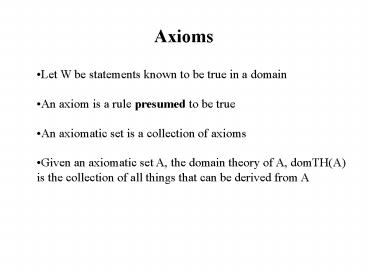Axioms - PowerPoint PPT Presentation
Title:
Axioms
Description:
Given an axiomatic set A, the domain theory of A, domTH(A) is the collection of ... A problem frequently studied by mathematicians: Given W ... Two Famous Quotes ' ... – PowerPoint PPT presentation
Number of Views:230
Avg rating:3.0/5.0
Title: Axioms
1
Axioms
- Let W be statements known to be true in a domain
- An axiom is a rule presumed to be true
- An axiomatic set is a collection of axioms
- Given an axiomatic set A, the domain theory of A,
domTH(A) is the collection of all things that can
be derived from A
2
Axioms (II)
- A problem frequently studied by mathematicians
Given W
can we construct a (finite) axiomatic set, A,
such that domTH(A) W?
- Potential difficulties
- Inconsistency
- Incompleteness
- Theorem (Goedel) Any axiomatic set for the
Arithmetic is either inconsistent and/or
incomplete
3
Recap from Previous Class
- First-order logic is not sufficient for many
problems
- We have only a degree of belief (a probability)
Decision Theory probability theory utility
theory
4
Utility of A Decision
- CSE 395/495
- Resources
- Russell and Norwicks book
5
Two Famous Quotes
To judge what one must due to obtain a good or
avoid an evil, it is necessary to consider not
only the good and the evil itself, but also the
probability that it happens or not happen
Arnauld, 1692
so they go in a strange paradox, decided only
to be undecided, resolved to be irresolute,
adamant for drift, solid for fluidity all
powerful to be impotent
Churchill, 1937
6
Utility Function
- The utility captures an agents preference
U States ? 0,?)
- Given an action A, let Result1(A), Result2(A),
denote the possible outcomes of A - Let Do(A) indicates that action A is executed and
E be the available evidence - Then, the expected utility EU(AE)
EU(AE) ?i P(Resulti(A) E, Do(A))
U(Resulti(A))
7
Principle of Maximum Expected Utility (MEU)
An agent should choose an action that maximizes EU
MEU says choose A for state S such that for any
other action A if E is the known evidence in S,
then EU(AE) ? EU(AE)
8
MEU Doesnt Solve All AI Problems
EU(AE) ?i P(Resulti(A) E, Do(A))U(Resulti(A))
Difficulties
- State and U(Resulti(A)) might not be known
completely - Computing P(Resulti(A) E, Do(A)) requires a
causal model. Computing it is NP-complete
Grade vs. knowledge
9
Lotteries
- We will define the semantics of preferences to
define the utility - Preferences are defined on scenarios, called
lotteries
- A lottery L with two possible outcomes A with
probability p and B with probability (1 p),
written - L p, A (1 p), B
- The outcome of a lottery can be an state or
another lottery
10
Preferences
- Let A and B be states and/or lotteries, then
- A ? B denotes A is preferred to B
- A B denotes A is indifferent to B
- A ? B denotes either A ? B or A B
11
Axioms of the Utility Theory
- Orderability
- Transitivity
- Continuity
- Substitutability
A ? B or B ? A or A B
If A ? B and B ? C then A ? C
B
p, B (1 p), C
12
Axioms of the Utility Theory (II)
- Monotonicity
- Decomposibility (No fun in gambling)
?
p, A (1 p), q, B (1 q), C
p, A (1 p)q, B (1 p)(1 q), C
13
Axioms of the Utility Theory (III)
- Utility principle
U States ? 0,?)
A ? B iff A B iff
U(A) gt U(B) U(A) U(B)
?i piU(Si)
14
Example
Suppose that you are in a TV show and you have
already earned 1000.000 so far. Now, the
presentator propose you a gamble he will flip a
coin if the coin comes up heads you will earn
3000.000. But if it comes up tails you will
loose the 1000.000. What do you decide?
First shot U(winning X) X MEU
15
Example (II)
If we use the expected monetary value of the
lottery does it take the bet?
Yes!, because MEU(0.5,0 0.5,3000.000)
1500.000 gt MEU(1,1000.000 0,3000.000)
1000.000
But is this really what you would do?
Not me!
16
Example (III)
Second shot
Let S my current wealth
S my current wealth 1000.000
S my current wealth
3000.000
MEU(Accept) MEU(Decline)
0.5U(S) 0.5U(S) U(S)
0.5U(S) 0.5U(S) U(S)
If U(S) 5, U(S) 8, U(S) 10, would you
accept the bet?
17
Human Judgment and Utility
- Decision theory is a normative theory describe
how agents should act
- Experimental evidence suggest that people violate
the axioms of utility Tversky and Kahnerman
(1982) and Allen (1953)
- Experiment with people
- Choice was given between A and B and then between
C and D
C 20 chance of 4000 D 25 chance of 3000
A 80 chance of 4000 B 100 chance of 3000
18
Human Judgment and Utility (II)
- Majority choose B over A and C over D
If U(0) 0
MEU(0.8,4000 0.2,0) MEU(1,3000 0,4000)
Thus, 0.8U(4000) lt U(3000)
MEU(0.2,4000 0.8,0) MEU(0.25,3000 0.65,
0)
Thus, 0.2U(4000) gt 0.25U(3000)
Thus, there cannot be no utility function
consistent with these values
19
Human Judgment and Utility (III)
- The point is that it is very hard to model an
automatic agent that behaves like a human (back
to the Turing test)
- However, the utility theory does give some formal
way of model decisions and as such is used to
support users decisions - Same can be said for similarity in CBR
20
Homework
- You saw the discussion on the utility relative to
the talk show example. Do again an analysis of
the airport location that was given last class
but this time around your discussion should be
centered around how to define utility rather than
the expected monetary value.































